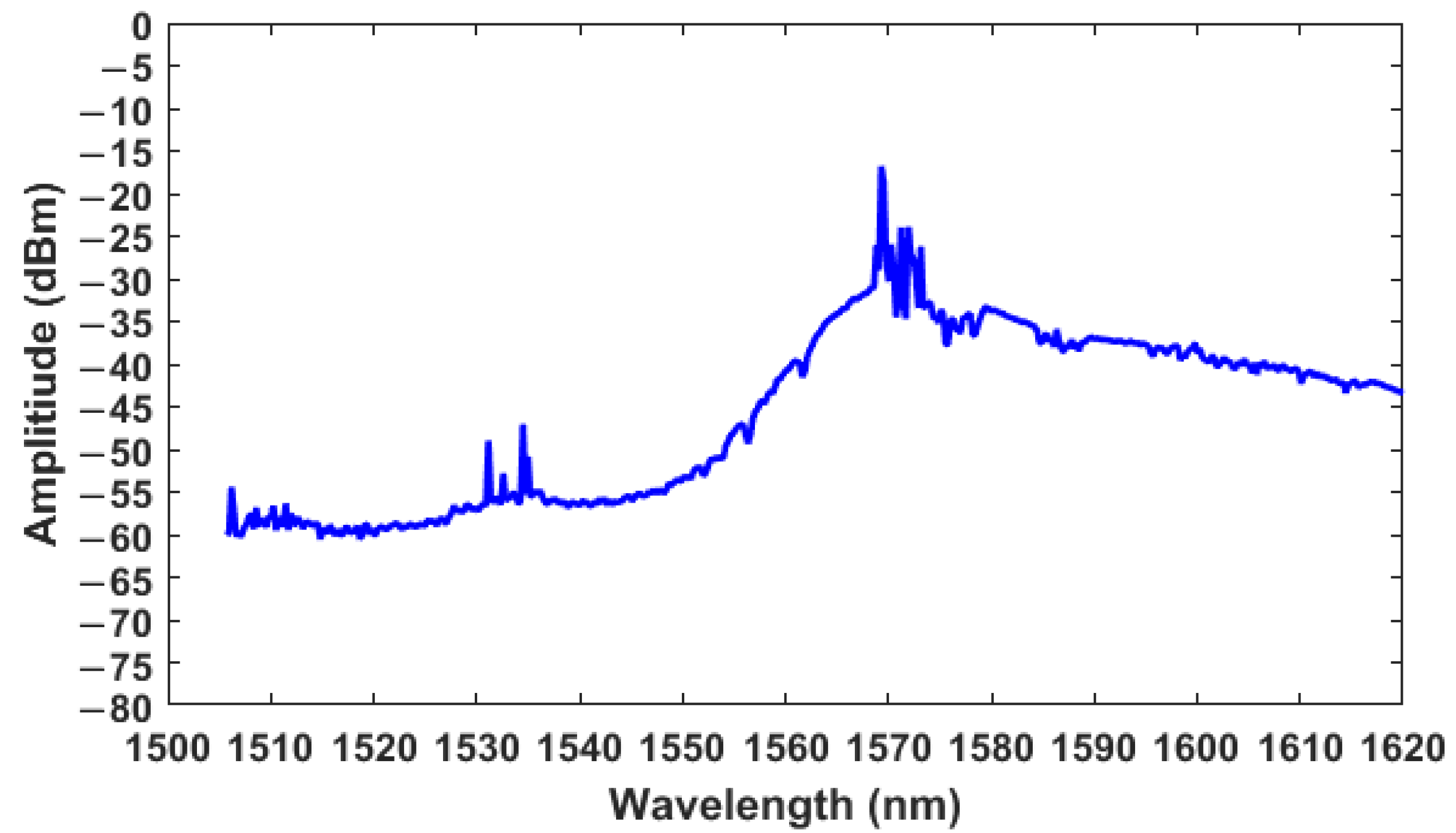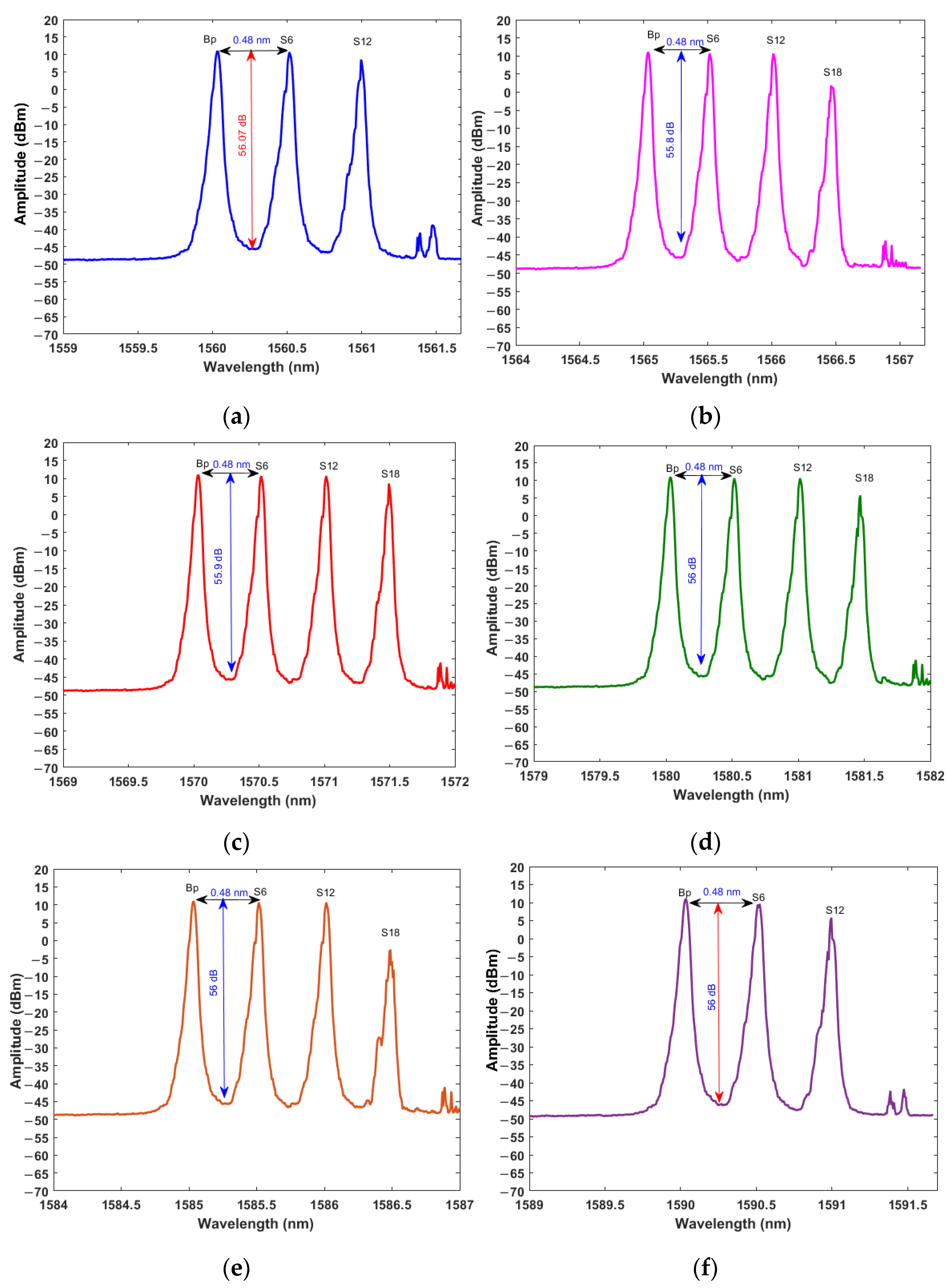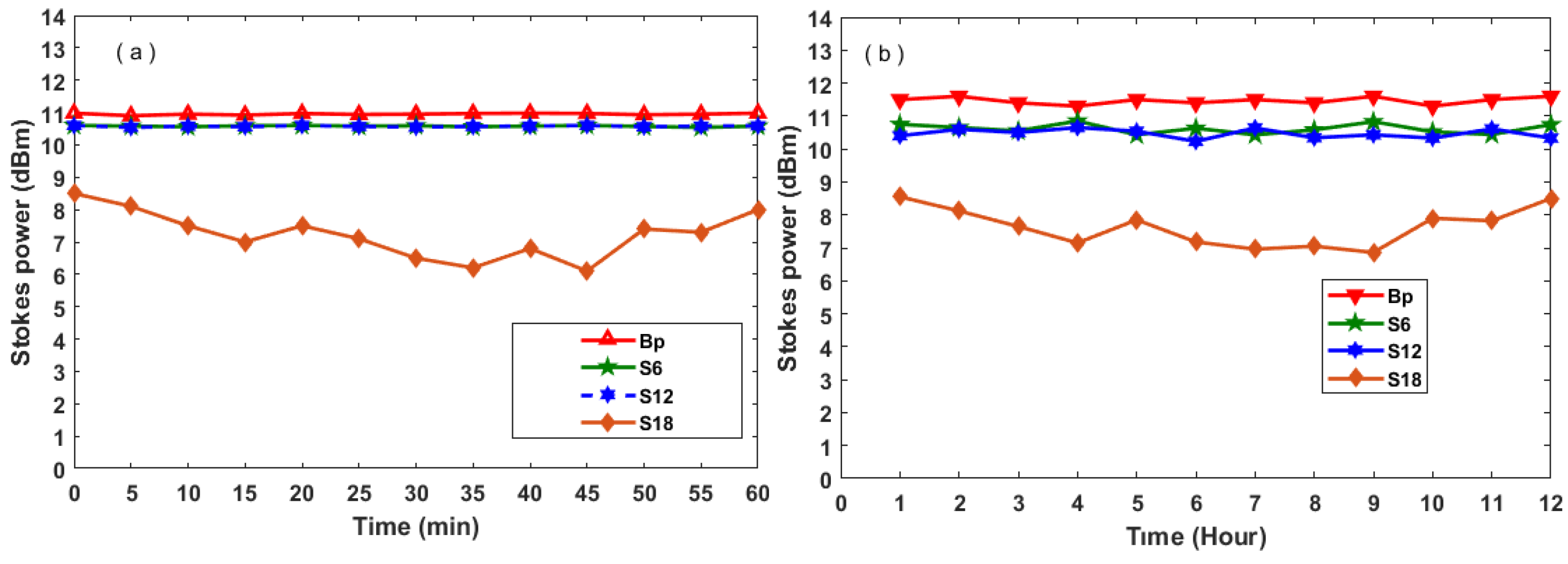Tunable 60 GHz Multiwavelength Brillouin Erbium Fiber Laser
Abstract
:1. Introduction
2. Experimental Setup
3. Results and Discussions
4. Conclusions
Author Contributions
Funding
Institutional Review Board Statement
Informed Consent Statement
Data Availability Statement
Acknowledgments
Conflicts of Interest
References
- Abdullah, M.K. Power Division Analysis of Optical Single Mode Branching Waveguides. J. Kejuruter. 1995, 7, 1–7. [Google Scholar]
- Stewart, G.; Johnstone, W.; Arsad, N.; Duffin, K. Tunable diode and fibre laser spectroscopy in the near-IR for measurement of gas parameters. Opt. Sens. 2008, 7003, 700319. [Google Scholar] [CrossRef]
- Arsad, N.; Stewart, G. Stable, tunable, and single-mode operation of an erbium-doped fibre laser system using a saturable absorber for gas spectroscopy applications. Fiber Lasers VI Technol. Syst. Appl. 2009, 7195, 719525. [Google Scholar] [CrossRef]
- Kashif, M.; Mokhtar, M.H.H.; Azeman, N.H.; Hashim, F.H.; Arsad, N.; Abushagur, A.A.G.; Bakar, A.A.A. Phase-interrogated surface plasmon resonance sensor based on laser feedback interferometry. Opt. Lasers Eng. 2021, 141, 106564. [Google Scholar] [CrossRef]
- Azeman, N.H.; Arsad, N.; Bakar, A.A.A. Polysaccharides as the sensing material for metal ion detection-based optical sensor applications. Sensors 2020, 20, 3924. [Google Scholar] [CrossRef] [PubMed]
- Kassa-Baghdouche, L. Optical properties of a point-defect nanocavity-based elliptical-hole photonic crystal for mid-infrared liquid sensing. Phys. Scr. 2019, 95, 15502. [Google Scholar] [CrossRef]
- Kassa-Baghdouche, L.; Cassan, E. Mid-infrared gas sensor based on high-Q/V point-defect photonic crystal nanocavities. Opt. Quantum Electron. 2020, 52, 260. [Google Scholar] [CrossRef]
- Ali, H.N.A.; Arsad, N.; Zulkipli, N.F.; Rosol, A.H.A.; Paul, M.C.; Yasin, M.; Harun, S.W. kHz pulse generation with Brillouin erbium fiber laser. Laser Phys. 2022, 33, 15102. [Google Scholar] [CrossRef]
- Gan, G.K.W.; Yeo, K.S.; Adikan, F.R.M.; Shee, Y.G. Four-wave-mixing-assisted Brillouin fiber laser with double-Brillouin-frequency spacing. Opt. Fiber Technol. 2015, 21, 198–201. [Google Scholar] [CrossRef]
- Al-Mansoori, M.H.; Mahdi, M.A. Multiwavelength L-band brillouin-erbium comb fiber laser utilizing nonlinear amplifying loop mirror. J. Light. Technol. 2009, 27, 5038–5044. [Google Scholar] [CrossRef]
- Parvizi, R.; Arof, H.; Ali, N.M.; Ahmad, H.; Harun, S.W. 0.16 nm spaced multi-wavelength Brillouin fiber laser in a figure-of-eight configuration. Opt. Laser Technol. 2011, 43, 866–869. [Google Scholar] [CrossRef]
- Al-Mashhadani, T.F.; Al-Mansoori, M.H.; Jamaludin, M.Z.; Abdullah, F.; Abass, A.K. Influence of a bidirectional recycling residual pump on the Stokes signal characteristics of a linear cavity Brillouin fiber laser. Laser Phys. 2013, 23, 85111. [Google Scholar] [CrossRef]
- Al-Mansoori, M.H.; Bouzid, B.; Ali, B.M.; Abdullah, M.K.; Mahdi, M.A. Multi-wavelength Brillouin-Erbium fibre laser in a linear cavity. Opt. Commun. 2004, 242, 209–214. [Google Scholar] [CrossRef]
- Al-Mashhadani, T.F. Erbium gain effects on Stokes signal performance in a Fabry–Perot Brillouin Erbium fiber laser. Opt. Quantum Electron. 2019, 51, 189. [Google Scholar] [CrossRef]
- Ajiya, M.; Mahdi, M.A.; Al-Mansoori, M.H.; Mokhtar, M.; Hitam, S. Directivity influence of signals propagation through EDFA gain medium of Brillouin-erbium fiber laser. Opt. Commun. 2009, 282, 4266–4270. [Google Scholar] [CrossRef]
- Tiu, Z.C.; Aidit, S.N.; Hassan, N.A.; Bin Ismail, M.F.; Ahmad, H. Single and Double Brillouin Frequency Spacing Multi-Wavelength Brillouin Erbium Fiber Laser with Micro-Air Gap Cavity. IEEE J. Quantum Electron. 2016, 52. [Google Scholar] [CrossRef]
- Al-Alimi, A.W.; Cholan, N.A.; Yaacob, M.H.; Abas, A.F.; Alresheedi, M.T.; Mahdi, M.A. Wide bandwidth and flat multiwavelength Brillouin-erbium fiber laser. Opt. Express 2017, 25, 19382. [Google Scholar] [CrossRef] [Green Version]
- Shee, Y.G.; Al-Mansoori, M.H.; Ismail, A.; Hitam, S.; Mahdi, M.A. Double Brillouin frequency shift through circulation of odd-order Stokes signal. Appl. Opt. 2010, 49, 3956–3959. [Google Scholar] [CrossRef]
- Ma, L.; Zou, H.; Xiong, H.; Wu, H.; Zhang, Y. Multiwavelength generation by using a novel Brillouin-erbium fiber laser with double linear-cavity based on a double-pass Brillouin Pump (BP) amplification technique. Opt. Laser Technol. 2019, 117, 169–174. [Google Scholar] [CrossRef]
- Tang, J.; Sun, J.; Chen, T.; Zhou, Y. A stable optical comb with double-Brillouin-frequency spacing assisted by multiple four-wave mixing processes. Opt. Fiber Technol. 2011, 17, 608–611. [Google Scholar] [CrossRef]
- Al-Mashhadani, T.F.; Al-Mashhadani, M.K.S.; Yucel, M.; Goktas, H.H. Influence of bidirectional cavity structure on the Brillouin Stokes signal characteristics in ring BFL. Optik (Stuttg.) 2019, 185, 359–363. [Google Scholar] [CrossRef]
- Shee, Y.G.; Al-Mansoori, M.H.; Yaakob, S.; Man, A.; Zamzuri, A.K.; Adikan, F.R.; Mahdi, M.A. Millimeter wave carrier generation based on a double-Brillouin-frequency spaced fiber laser. Opt. Express 2012, 20, 13402–13408. [Google Scholar] [CrossRef] [PubMed]
- Abass, A.K.; Al-Mansoori, M.H.; Jamaludin, M.Z.; Abdullah, F.; Al-Mashhadani, T.F.; Ali, M.H. L-band multi-wavelength brillouin-raman fiber laser with 20-GHz channel spacing. Fiber Integr. Opt. 2014, 33, 56–67. [Google Scholar] [CrossRef]
- Qian, L.; Fen, D.; Xie, H.; Sun, J. A novel tunable multi-wavelength Brillouin fiber laser with switchable frequency spacing. Opt. Commun. 2015, 340, 74–79. [Google Scholar] [CrossRef]
- Zhou, X.; Liu, Y.; Hu, M.; Wei, Y.; Lu, Y.; Yang, G.; Bi, M.; Li, Q. Multi-Wavelength Brillouin Fiber Laser with Triple Brillouin Frequency Spacing. IEEE Photonics Technol. Lett. 2016, 28, 2379–2382. [Google Scholar] [CrossRef]
- Wang, X.; Yang, Y.; Liu, M.; Yuan, Y.; Sun, Y.; Gu, Y.; Yao, Y. Frequency spacing switchable multiwavelength Brillouin erbium fiber laser utilizing cascaded Brillouin gain fibers. Appl. Opt. 2016, 55, 6475. [Google Scholar] [CrossRef]
- Al-Mansoori, M.H.; Al-Sheriyani, A.; Al-Nassri, S.; Hasoon, F.N. Generation of efficient 33 GHz optical combs using cascaded stimulated Brillouin scattering effects in optical fiber. Laser Phys. 2017, 27, 65112. [Google Scholar] [CrossRef]
- Wang, Z.; Wang, T.; Jia, Q.; Ma, W.; Su, Q.; Zhang, P. Triple Brillouin frequency spacing multiwavelength fiber laser with double Brillouin cavities and its application in microwave signal generation. Appl. Opt. 2017, 56, 7419. [Google Scholar] [CrossRef]
- Al-Mansoori, M.H.; Al-Sheriyani, A.; Younis, M.A.A.; Mahdi, M.A. Widely tunable multiwavelength Brillouin-erbium fiber laser with triple Brillouin-shift wavelength spacing. Opt. Fiber Technol. 2018, 41, 21–26. [Google Scholar] [CrossRef]
- Al-Mashhadani, T.F.; Al-Mashhadani, M.K.S.; Goktas, H.H.; Yucel, M.; Celebi, F.V. Widely triple Brillouin frequency shift multiwavelength Brillouin erbium fiber laser. Opt. Quantum Electron. 2020, 52, 228. [Google Scholar] [CrossRef]
- Jia, Q.; Zhang, P.; Wang, T.; Li, X.; Bo, B. 40 GHz narrow linewidth frequency-switched microwave signal generation based on a single-longitudinal-mode double-Brillouin-frequency spaced Brillouin fiber laser. Appl. Opt. 2017, 56, 5323. [Google Scholar] [CrossRef] [PubMed]
- Al-Mashhadani, M.K.S.; Al-Mashhadani, T.F.; Goktas, H.H. Broadly tunable 40 GHz Brillouin frequency spacing multiwavelength Brillouin–Erbium fiber laser for DWDM. Opt. Commun. 2019, 451, 116–123. [Google Scholar] [CrossRef]
- Al-Mashhadani, M.K.S.; Al-Mashhadani, T.F.; Goktas, H.H. Tunable 50 GHz laser comb generation of multiwavelength Brillouin erbium fiber laser. Opt. Commun. 2020, 464, 125542. [Google Scholar] [CrossRef]








| Ref. No. | No. of Stokes | Tuning Range (nm) | Channel Spacing GHz | Description |
|---|---|---|---|---|
| [24] | 2 | 22 | 30 |
|
| [25] | 10 | 35 | 30 |
|
| [26] | 4 | not covered | 30 |
|
| [28] | 9 | only at the center wavelength | 30 |
|
| [29] | 3 | 40 | 30 |
|
| [26] | 3 | not covered | 40 |
|
| [31] | 1 | not covered | 40 |
|
| [32] | 4 | 60 | 40 |
|
| [33] | 4 | 40 | 50 |
|
| our work | 4 | 30 | 60 |
|
Disclaimer/Publisher’s Note: The statements, opinions and data contained in all publications are solely those of the individual author(s) and contributor(s) and not of MDPI and/or the editor(s). MDPI and/or the editor(s) disclaim responsibility for any injury to people or property resulting from any ideas, methods, instructions or products referred to in the content. |
© 2023 by the authors. Licensee MDPI, Basel, Switzerland. This article is an open access article distributed under the terms and conditions of the Creative Commons Attribution (CC BY) license (https://creativecommons.org/licenses/by/4.0/).
Share and Cite
Awsaj, M.K.; Al-Mashhadani, T.F.; Al-Mashhadani, M.K.S.; Hammudi, R.N.; Ali, A.y.; Zan, M.S.D.; Arsad, N. Tunable 60 GHz Multiwavelength Brillouin Erbium Fiber Laser. Appl. Sci. 2023, 13, 3275. https://doi.org/10.3390/app13053275
Awsaj MK, Al-Mashhadani TF, Al-Mashhadani MKS, Hammudi RN, Ali Ay, Zan MSD, Arsad N. Tunable 60 GHz Multiwavelength Brillouin Erbium Fiber Laser. Applied Sciences. 2023; 13(5):3275. https://doi.org/10.3390/app13053275
Chicago/Turabian StyleAwsaj, Mohammed K., Thamer Fahad Al-Mashhadani, Mohammed Kamil Salh Al-Mashhadani, Rabi Noori Hammudi, Ali yaseen Ali, Mohad Saiful Dzulkefly Zan, and Norhana Arsad. 2023. "Tunable 60 GHz Multiwavelength Brillouin Erbium Fiber Laser" Applied Sciences 13, no. 5: 3275. https://doi.org/10.3390/app13053275








